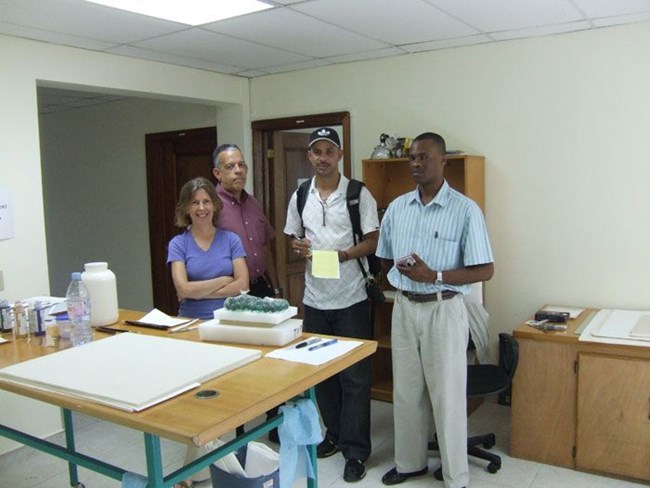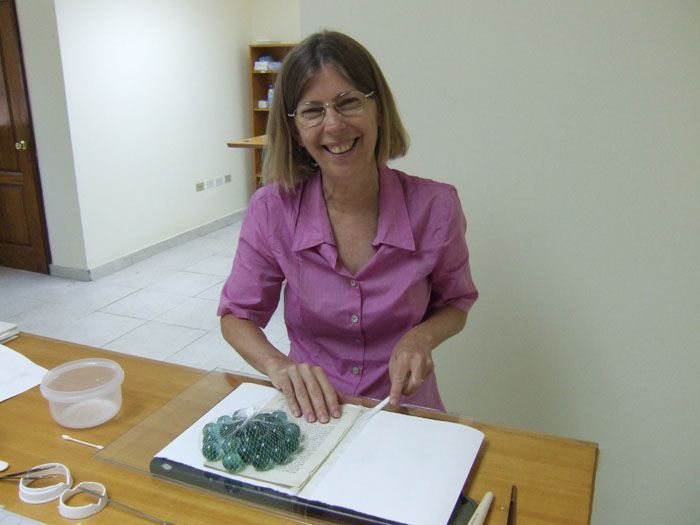
Karen Pavelka
2010 Catastrophic Earthquake in Haiti
Jason Church: As we all know, on Jan. 12, 2010 there was a catastrophic earthquake in Haiti that devastated the country and Karen, you’ve just come back from doing some work in Haiti. What exactly were you doing there?
Karen Pavelka: I was helping to setup the lab at the Cultural Recovery Center in Port-au-Prince. I went down with two other conservators, a painting’s conservator, David Goist and an objects conservator, Bev Perkins, and the center was just getting started at that point. We were bringing materials in and organizing.
Karen Pavelka: There was a delegation of potential donors coming through and one of the reasons they had us there was to talk to the potential donors and tell them about the importance of the project and explain what conservation could and couldn’t do down there , and to try to build support. So, mine was pretty much, a planning and organizational visit. I got to do a little bit of treatment but not so much. Mostly, I got to lead tours, participated in workshops, help stand in as a teacher in workshops, it’s a very unstructured environment.
Students in Workshops
Jason Church: Who were you training in these workshops?
Karen Pavelka: Everything in Haiti is chaotic as you might imagine, and you don’t exactly know what you’re going to be doing day to day, so one day I showed up at the Center and some people from the West Indies happened to show up and said that they were going to be teaching a workshop to librarians and archivists the next day showing basic preservation techniques. So, I got to talk to them about basic conservations techniques and what one can and can’t do in a small space. It was two conservators from the West Indies who were working with people from Haiti, teaching people from Haiti.
The Conservation Resource Center, Port-au-Prince, Haiti
Jason Church: The Conservation Resource Center that they have established now that you helped establish there in Port-au-Prince, what is that like? How large is it, who is it going to service, who’s funding it, that sort of thing?
Karen Pavelka: It’s not what you’re used to when you think of a conservation lab. It’s in a building that used to be a suite of offices. The building had been inhabited by the U.N. and the reason the site was chosen was because the building is very structurally sound. It didn’t fall over in the earthquake and it doesn’t look like it’s likely to fall over if there is another earthquake.
Karen Pavelka: It also happens to have a large fence around it; I guess about and 8 or 10 foot fence and a post where you can have armed guards. So, it was chosen for security and probably proximity to other environments, but it wasn’t chosen as an ideal lab space. We set up tables and shelves where we could get them and there are three labs there, they’re calling them labs, each one of them has a large room or a couple of large rooms and then there will be a smaller room down the hall that has a sink, and they all have bathrooms next to them.
Karen Pavelka: There is no real area for wet treatment. You carry all the water in and out of the working space. There are big jugs of distilled water, but you know, it’s pretty much an office space. It’s very beautiful, it’s quite a beautiful country, and the space itself is lovely but more of an office suite than a lab.
Who will perform conservation work?
Jason Church: Who do they plan to be doing the actual work there?
Karen Pavelka: The project is organized by the Smithsonian. They are the ones who are spearheading the project, and they’re working with a number of other institutions, AIC being a very prominent member. So far, most of the conservators who have gone down have been organized through AIC, the American Institute for Conservation. AIC has served as a sort of clearinghouse to accept applications from conservators and coordinate travel and send them down. Stephanie Hornbeck is an American Objects Conservator, and she’s the chief conservator on the project.
Karen Pavelka: She is organizing all the conservation efforts. She is going out and selecting the objects for treatment and talking to the people in the collections, make alliances with people in collections. The very first thing people had to do was to convince people that it was safe to send their objects to the Center.
Karen Pavelka: Everything in Haiti as you might imagine, is pretty chaotic right now. So people weren’t exactly willing to say, “Oh good, I’m going to give you my most valuable object” because there’s a certain amount of distrust. Stephanie and the other staff at the Cultural Recovery Center have been making friends with the community doing outreach and letting people know that they can send their objects here, setting up tours, showing them some work that’s been done.
How are objects chosen for treatment?
Jason Church: Well, how are the objects chosen that are being treated?
Karen Pavelka: They will work on things that people bring them. They are not choosing the objects, they’re telling people and the arts community that they can bring objects to the Center and the Center will treat them. They have a huge backlog of paintings. Right now the paintings are, I think they’re still mostly from private galleries but the thought is that they’ll be working with museums as well. They’re being pretty democratic about the work that they take in. They’ll take in work from pretty much everyone.
What are the conditions in Haiti?
Jason Church: As it pertains to cultural materials and resources, what are the conditions in Haiti right now?
Karen Pavelka: Horrible, absolutely horrible. There’s rubble everywhere. I saw one dump truck the entire time I was in Haiti. The streets haven’t been cleared, the electricity is sporadic, all of the hotels are running on generators. There is no central power or very little. The houses of the more well to do people, the hotels that we were staying in, for anyone who can afford it, are running generators to keep power and even they go out periodically, so you know the power is going to go off periodically while you’re there.
Karen Pavelka: As I said the streets are just filled with rubble, they’re still clearing collapsed buildings by hand. You see people digging through piles of rubble and pulling out the bricks and the rebar that they might be able to fashion into some sort of dwelling. All those pictures of houses that you see, the blue tents that people are living in, those seem to be the upper middle class ones. A lot of what you see on the street is much worse than that, and I was there before the rains really began in earnest. There was some rain but not tons of rain. The conditions are unbelievable.
Backlog of objects and freeze drying of wet materials
Jason Church: When you were there in July and saw the conditions you saw, that was really before the hurricane seasonal rains that they are having, so I’m sure that works of art on paper and of course canvases and mold issues must be extravagant right now. I can’t imagine what they must be seeing at the Cultural Center as they bring in these works of art. Are they having a backlog of objects and if so, how are they, I know with electricity issues, are they having to freeze objects to withstand the mold and that sort of thing?
Karen Pavelka: Freezing probably isn’t so much of a possibility right now because of the electricity. After the earthquake, they did a lot of work to salvage as many things as they could and just get them in a dry situation, you know, to pull them out of the rubble and just put them somewhere where they would be safe. I’m sure that there will be a lot more mold when their rains come because I have no idea what condition some of the buildings are going to be in where the artifacts are housed, so I can’t say anything about whether or not they have leaky roofs or anything like that.
Karen Pavelka: I’d be surprised if they don’t but who knows. The Center does have a backlog of materials that they work on. They had a backlog when I was there, and I’m pretty sure it’s only increased since I got back. They’re storing them in the Center and that was one of the reasons that they picked the space that they did. It had enough room not only to work on objects, but to store things that people would work on later on.



